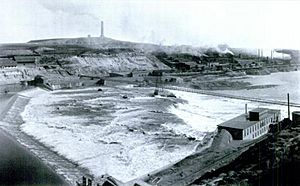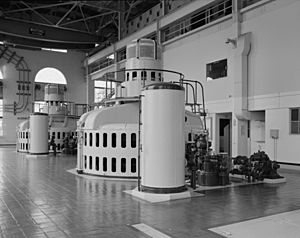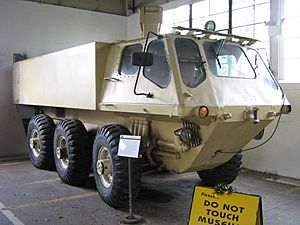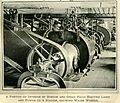Black Eagle Dam facts for kids
Quick facts for kids Black Eagle Dam |
|
|---|---|
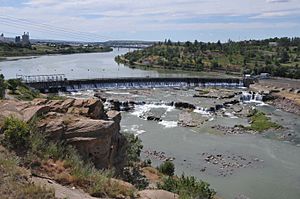
Black Eagle Dam in 2013
|
|
| Official name | Black Eagle Dam |
| Location | Great Falls, Montana, U.S. |
| Coordinates | 47°31′11″N 111°15′47″W / 47.51972°N 111.26306°W |
| Construction began | September 1890 (first dam); April 1926 (second dam) |
| Opening date | December 1890 (first dam); September 1927 (second dam) |
| Operator(s) | NorthWestern Corporation |
| Dam and spillways | |
| Impounds | Missouri River |
| Height | 34.5 feet (10.5 m) (second dam) |
| Length | 782 feet (238 m) (second dam) |
| Reservoir | |
| Creates | Long Pool |
| Power station | |
| Installed capacity | 18 MW |
| Annual generation | 142,590,000 KWh (2009) |
The Black Eagle Dam is a dam on the Missouri River in Great Falls, Montana. It helps create electricity from water power. The first dam here was made of wood and rock. It opened in 1890. This was the very first hydroelectric dam in Montana and on the Missouri River! It helped Great Falls get the nickname "The Electric City."
A newer, stronger dam made of concrete was built in 1926 and opened in 1927. It replaced the old wooden dam, which is still underwater behind the new one. The current dam is about 782 feet (238 meters) long and 34.5 feet (10.5 meters) high. It has three turbines that can make 18 megawatts (MW) of power. That's enough electricity for many homes!
The dam is owned by NorthWestern Corporation. The water behind the dam is called the Long Pool. It's about 2 miles (3.2 km) long and can hold a lot of water. The Black Eagle Dam is a "run-of-the-river" dam. This means it can make electricity without needing to store extra water.
Contents
What are the Black Eagle Falls?
Black Eagle Falls is the first of five amazing waterfalls on the Missouri River in Montana. Before the dam was built, the water dropped about 26 feet (8 meters) here.
These falls formed because of different types of rock. The Missouri River flows over sandstone rock. Some of this rock is softer and wears away easily. The harder rock stays, forming the waterfalls.
Native American tribes like the Mandan and South Piegan Blackfeet knew about these falls. In 1805, Meriwether Lewis of the Lewis and Clark Expedition was the first white person to see the Great Falls. He discovered Black Eagle Falls on June 14, 1805. He wrote about an eagle's nest on an island in the middle of the river. The falls were later named "Black Eagle Falls" because of this eagle.
The First Dam (1890)
In 1887, a company called Great Falls Water Power & Townsite Company (GFWPTC) was formed. Their goal was to develop the city of Great Falls. They wanted to provide power and attract businesses. James J. Hill, a railroad leader, helped organize the investors.
One of the company's owners, Paris Gibson, realized that the Great Falls of the Missouri River could provide lots of cheap electricity. This would be great for industries. So, the company started buying land and water rights along the river.
The Black Eagle Dam was built to power a copper smelter. In 1889, GFWPTC agreed to build a dam that would provide power for a mining company. In return, the mining company agreed to build a large copper smelter nearby.
Construction of the first Black Eagle Dam began in 1890. Engineers designed a dam made of heavy timbers filled with rocks. It wasn't a huge dam. Its purpose was to create a pond of water behind it. This water pressure would turn turbines and make electricity. The dam cost about $515,000 at the time.
Workers from different countries helped build the dam. They lived in a small town called "River Bank" nearby. The dam was 15 feet (4.6 meters) high and 1,100 feet (335 meters) long. It started making electricity in December 1890.
There were two powerhouses. One was on the south side of the river. It had three turbines that made 1.27 MW of power each. The other powerhouse was on the north side. It had seven more turbines. Most of the power from the north powerhouse was used directly by the smelter's machines through ropes and pulleys.
How the 1890 Dam Operated
The copper smelter opened in stages between 1891 and 1893. By 1892, over 1,000 people worked there. In 1908, a very tall chimney, called the "Big Stack," was finished at the smelter. It was the tallest chimney in the world at that time!
In 1908, another dam upstream, Hauser Dam, broke. A huge wave of water rushed downstream. Workers at the smelter tried to protect their plant by blowing up part of Black Eagle Dam. This was to let the floodwaters pass. Luckily, the water only rose a little in Great Falls.
Just two months later, in June 1908, Black Eagle Dam was damaged by another flood. Heavy rains caused the Missouri River to rise very high. Buildings in town were washed away and crashed into the dam. The pedestrian bridge over the dam was also destroyed. The dam was repaired, and a new steel bridge was built.
Ownership of the dam changed over time. In 1912, several power companies merged to form the Montana Power Company. This company then owned Black Eagle Dam. In 1913, Montana Power upgraded the dam to make more electricity. They replaced old equipment with newer, more powerful turbines.
The New Dam (1926)
By the early 1920s, the city of Great Falls and the smelter needed even more electricity. The old Black Eagle Dam couldn't provide enough. So, the Montana Power Company decided to build a brand new dam.
Work on the new dam began in the summer of 1926. The old dam was used to hold back the river while workers poured concrete for the new one. The new dam was finished on August 1, 1927, and started making electricity in September. The new dam's reservoir completely covered the old dam.
The new dam is 782 feet (238 meters) long and 34.5 feet (10.5 meters) high. It has a special curved shape at the top to help water flow smoothly over it. It also has eight floodgates to control water levels. A walkway along the top helps maintenance workers.
The new powerhouse was built from concrete. It has three powerful Kaplan turbines that can generate 18 MW of power. This made Black Eagle Dam the most powerful of Montana Power's dams in the Great Falls area at the time.
The Black Eagle Dam has survived four major floods since it was rebuilt in 1926. Even during a huge flood in 1964, which was worse than the 1908 flood, the dam was not damaged. The dam also has an emergency system that can release all the flashboards (movable gates) to let a lot of water pass over it quickly.
The Long Pool Reservoir
The Black Eagle Dam created a reservoir about 2 miles (3.2 km) long behind it. This reservoir holds between 1,710 and 1,820 acre-feet (2.1 to 2.2 million cubic meters) of water.
This reservoir doesn't have an official name, but it's been known as the "Long Pool" for a long time. It got this name because the water is slow and still in this area. Today, part of this area is called Broadwater Bay.
How the Dam Operates Today
After the dam was rebuilt in 1926, people could walk across the top of it to get to work or school. But during World War II, the dam was closed for security reasons and never reopened for public walking.
In 1950, the Montana Power Company had to get a special license for Black Eagle Dam and its other dams. This was because the government decided that the rivers they were on were "navigable waters." This means they are important for travel and trade.
The dam's generators were updated in 1978 and 1982. In 1999, Montana Power sold all its dams, including Black Eagle Dam, to another company called PPL, Inc. In 2014, NorthWestern Corporation bought the dam.
PPL Montana also gave most of Tailrace Island (an island near the dam) to the city of Great Falls. It's now a recreation area. They also cleaned up the island and made it safer.
Some people have suggested removing Black Eagle Dam to bring back the waterfalls to their original state.
The dam's power lines and equipment were updated starting in 2010. This made the system more reliable and safer for large birds.
Water and Debris Challenges
The Missouri River carries a lot of sediment (like mud and sand). This is a problem for Black Eagle Dam. The Sun River, which joins the Missouri upstream, adds a lot of sediment. This silt can reduce the reservoir's capacity and damage the power plant. Efforts are being made to reduce the amount of sediment flowing into the river.
Sometimes, the Black Eagle Falls don't flow much. This happens when water levels behind the dam are lowered for repairs or due to dry conditions. The dam's license requires it to send a certain amount of water over the falls on weekends and holidays during summer.
Because water flows over the dam, debris often gets stuck against it. This includes logs, but also unusual things like boat docks, bowling balls, and even small buildings! Workers use cranes and a special amphibious vehicle (a vehicle that can go on land and water) to remove these items. About 100 animal carcasses also get stuck each year. Ice can also be a problem, especially in winter.
The dam's owners have to practice for emergencies every year. They work with local police and government to plan for floods, mechanical problems, or other issues that could affect the dam and public safety.
Taxes and Riverbed Ownership
There have been some disagreements about how the dam is taxed. Also, there was a legal case about who owns the riverbed under the dam. Some people argued that all riverbeds in Montana belong to the state and should be taxed to help public schools. The case went all the way to the Supreme Court of the United States. In 2012, the Supreme Court said that only parts of the riverbed that were "navigable" (meaning boats could travel on them) when Montana became a state could be taxed. The case was sent back to Montana to figure out which parts were navigable.
Fun Activities and Wildlife
Fishing and Water Quality
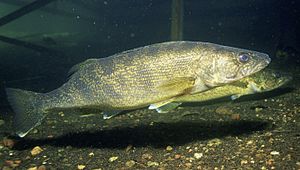
The river around Black Eagle Dam is a popular spot for fishing. You can find different types of trout, smallmouth bass, and walleye here. There are rules about how many fish you can catch. The dam doesn't have screens to stop fish from going over the dam or through the turbines. Dam operators say the fish usually pass through without problems.
The water quality in the Long Pool and the Missouri River near Great Falls has some issues. It has been listed as "impaired" due to sediment and other chemicals like mercury and chromium. These come from sources like old mines, irrigation, and stormwater runoff. Efforts are being made to improve the water quality.
In 2011, the old smelter next to Black Eagle Dam was listed as a Superfund site. This means it's a place with hazardous waste. The EPA (Environmental Protection Agency) is testing the riverbed for heavy metals like copper and lead. Historically, waste was dumped into the river here.
Wildlife and Hunting
Even though it's near a city, the area around the falls is home to many animals and birds. You might see bald eagles, Canada geese, ospreys, and many types of ducks. Animals like beavers, mule deer, and river otters also live here. Beavers are so common that they sometimes chew down trees in city parks!
Hunting is allowed in some areas around the dam, but not in the Long Pool reservoir itself. Hunters need to check maps and rules before going.
Recreation Area Fun

Black Eagle Dam is also a great place for outdoor activities. You can go canoeing, kayaking, hiking, and bicycling. There's an annual Black Eagle Dam Run and the Lewis and Clark Festival, which celebrates the discovery of the Great Falls.
The Lewis & Clark National Historic Trail Interpretive Center is a museum nearby. It tells the story of Lewis and Clark's journey through Montana.
Over the past 20 years, a lot of work has been done to create public access and viewing areas around the dam. The River's Edge Trail is a paved and gravel path along the river. In 2001, Tailrace Island was renamed Black Eagle Memorial Island to honor workers who died at the dam. A new boathouse, observation decks, and restrooms were built there. The island is now open to the public for free.
The city of Great Falls has a plan to improve public access, recreation, and beauty along the Missouri River, including areas around Black Eagle Dam.
Even today, you can still see the ruins of the old powerhouses from the 1890 dam and the 1913 reconstruction.
Images for kids


